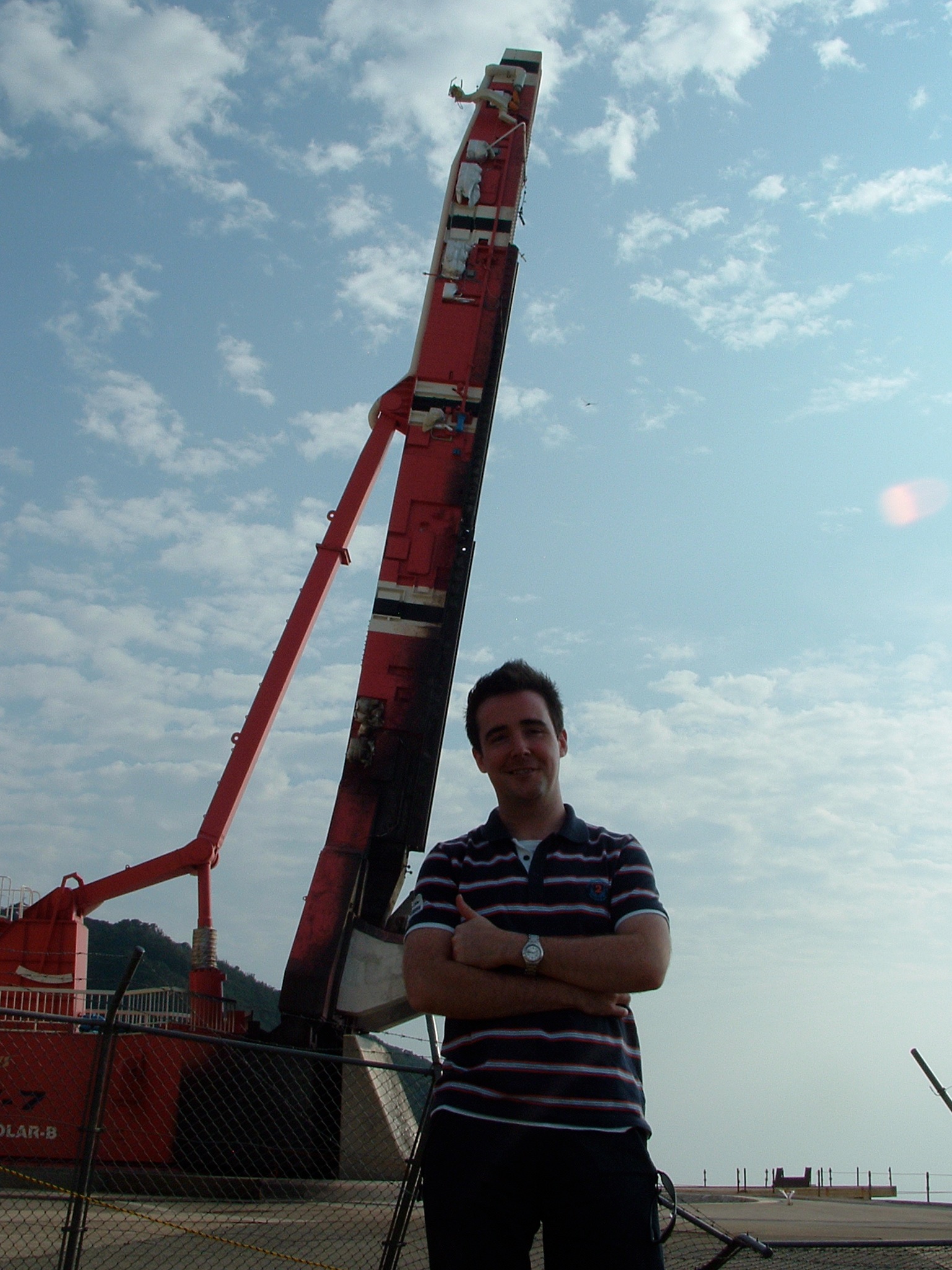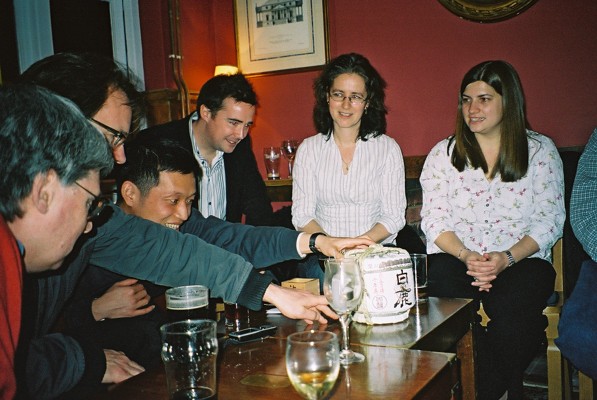This month's nugget celebrates five years of observations with the Extreme Ultraviolet Spectrometer (EIS) onboard Hinode. On October 28th 2006, EIS made its first observations of the solar corona, marking the start of a new era in solar spectroscopy. Since then, EIS has made observations of the Sun allowing us to gain plasma diagnostics in unprecedented detail across the temperature range 50,000 K to 20 million K.
In this nugget we take a light-hearted look over past events and the memories of the people who made EIS a reality. The team of people behind the EIS telescope is enormous. They can't all be named here, but the team spans Japan, the UK, the USA and Norway. This is reflected by the fact that there are Japanese (Tetsuya Watanabe), UK (Len Culhane followed by Louise Harra) and US (George Doschek) Principle Investigators for EIS.
It was Tetsuya Watanabe who first proposed the idea for EIS in 1993. A mission concept for Solar-B (renamed to Hinode in 2006) was being developed by the Japanese Space Agency and Watanabe proposed to have a spectrometer included in the spacecraft concept. Until that time, Solar-B included only white light and X-ray telescopes enabling the photosphere and corona to be observed. The addition of EIS meant that the three telescopes in the enhanced mission concept made a powerful observatory to probe questions about the causes of solar variability and the origins of solar activity. Although a huge number of people came together to make EIS a reality, two people have been crucial to the instrument's success; they are of course Len Culhane and George Doschek.

Len Culhane (left) and George Doschek (right) celebrating the successful launch of Hinode. Image courtesy of Dave Williams.
(Click figure to see full-size image)
To turn the EIS instrument concept into reality of course requires a dedicated team of engineers. Ady James, EIS project manager at MSSL, commented on building the structural model, "It was during a meeting at Birmingham University in 2002 that the project, for me, was the most enjoyable. We were at the point of making final decisions on the design details of the structure. With each decision made, the concept we all had of EIS started to become more real, and there was a feeling that a final, workable design was coming together. It's hard to describe, but it is only with the physical structure of the instrument, and when that comes together, that there is a feeling of solidity to the project as a whole."
Of course the challenges of making a bespoke telescope that will function in the harsh space environment are significant, and there have been lows as well as highs. Charlie Brown recalls a vibration test in 2006, part of the standard testing for instruments before launch.
"Well the absolute worst moment was when we did a shake test and the lids dumped a bazillion cfrp patricles all over the optics and CCDs. I thought we might be done at that point."
Hirohisa Hara, who joined the project in 1994 and helped define the instrument, (Japanese project manager for EIS) said, "I felt a few times that EIS may not be realized. Each situation was rescued by the effort and wisdom of the PIs and others. I admire them for their contributions."
Despite set-backs, EIS was successfully built, tested and integrated into the Hinode spacecraft and was launched on the final flight of the M-V-7 rocket from Uchinoura Space Center, Japan on 22 September 2006 at 21:36 UT.
Dave Brooks (NRL resident scientist in Japan) commented, "The combination of excitement at the launch and nervousness that something might go wrong (I had a friend who worked on Cluster...) is difficult to describe, and then they exacerbate the whole thing by having a countdown!!"

The launch of Hinode from Uchinoura Space Center, Japan on 22 September 2006 at 21:36 UT. Launch image courtesy of Dave Williams. (Click figure to see full-size image)
Hara was also there for the launch "Personally, I felt impressed during the final inspection of EIS at the launch site. The penciled sketch on the notebook was realized on the spacecraft through a lot of effort by dedicated team members."
With the successful launch done, the next phase was to open doors at the front of EIS that had protected its delicate filters during the launch. Then came the commissioning of EIS to check that all parts worked!
The opening of the telescope doors and the first images recorded are known as ‘first light’. Of the 3 telescopes onboard Hinode EIS was the last to achieve first light – the doors of the other two telescopes needed to be opened first to prevent small particles that might be released during this process landing on, and damaging, the very fine filters on EIS. This was a nail biting time, especially for resident scientists from MSSL and NRL, Dave Williams and Dave Brooks. The pressure was on after the two other telescopes onboard Hinode had successfully opened their doors!
All went smoothly and the doors of EIS were opened on Saturday 28th October 2006. Successful data quickly followed.
Dave Williams commets, "those of you huddled around the tiny computer screen with me in B-Toh are unlikely to forget the moment we got those data back... I can only imagine how nerve-wracking it was to be elsewhere."

The first spectra returned by EIS on 28th October 2006.
(Click figure to see full-size image)
After launch, the Japanese Space Agency and the offices from where EIS was controlled, naturally became a focal point for solar physics. Many scientists around the word travelled to work with the data and the team operating the instrument. Dave Williams comments, "it was like being in Hollywood, all the famous names in science were there."

A (young!) Dave Williams standing by the rocket launch tower two hours after Hinode launched on the last of the Mu-V rockets (image courtesy of Dave Williams)(Click figure to see full-size image)
For any young readers interested in a career in space science, it is a good idea to consider being the resident scientist at the host institute in the months after mission launch. It is an exciting time and there is the opportunity to interact with scientists from many different fields.

Members of the team gather for sake tasting after a meeting in 2007. Images courtesy of Helen Mason.(Click figure to see full-size image)

Members of the team gather for sake tasting after a meeting in 2007. Images courtesy of Helen Mason.(Click figure to see full-size image)
The international EIS team has continued to meet regularly. EIS team member Helen Mason fondly remembers the many team meetings, including those with entertainment. Sake tasting being a favourite!
Initially planned as a three-year mission, Hinode and all its telescopes are still operating well today. A significant data archive now exists that spans half a solar cycle, including a wonderful dataset where the full sun has been regularly recorded. Below is a movie showing this full Sun over two years from Ignacio Ugarte-Urra from the Naval Research Laboratory.
If you want to add your memories of EIS for inclusion in future nuggets please contact Lucie Green.


